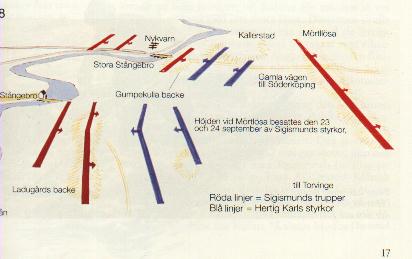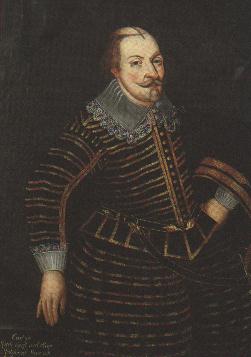

![]()
ERIK XIV: The first ambitions into the baltic states. |
Erik XIV |
After some time of political fighting about the right to have crowns and leopards in the coat of arms a seabattle was fought between a danish navy and a Swedish force under Jacob Bagge. In the end the Swedish had captured the danish flagship as well as two other ships. The danish admiral, Jakob Brockenhus, was brought to Stockholm in disgrace with shaven head.In the mean time Erik had developed an interest in the baltic question. Representatives from the town Reval had met the king to negotiate for protection from the Swedes since czar Ivan the terrible had conquered Narva. Thus the first Swedish step into the baltic region is taken. Since Russia, Poland and Denmark all had ambitions in this area constant confronation was inevitable. It begins well. Klas Kristersson Horn defeats all oppostion around Reval and the estonian nobility allies with the Swedish. Estonia becomes swedish in 1561.But in doing this Erik has offended not only foreign kings but his brother Johan, duke of Finland, as well. Johan had ambitions to enlarge his land into Estonia. In an attempt to ally himself with the poles he married the polish princess Katarina Jagelonica. Poland being larger, wealthier and more powerful than Sweden was a good ally. Erik reacted by accusing Johan of treason, having given his land to the poles as a morning gift. Johan was convicted and sentenced to death but was pardoned. He was imprisoned in 1563 while most of his accociates were executed. |
The nordic seven-year war with Denmark |
Klas Kristersson Horn |
At sea Klas Kristersson Horn has success. After a battle in july 1566 with the Swedish the danish navy withdraws into Visby harbour on Gotland. At night a storm hits the baltic sea and the danish navy in the harbour is destroyes when the ships are blown into each other. Bteween 4000-7000 danish sailors drown when 15 ships go down. The swedish fleet manage to ride the storm out without loss on the open sea. Klas Kristersson Horn died of the plague two months later. |
Eriks insanity and Johans coup. |
Johan III |
Johan, being 31 years old, was an intellectual and highly educated. He knew german, latin, polish, italian, french, english and finnish. On the contrary to Erik he took his marital vows seriously and was faithful. Johan was as his father, Gustaf Vasa, suspiciuos and choleric. It was a hard days work ahead. War with Denmark, problems with the czar, problems in Estonia.Daniel Rantzau returned with another army and besieged Varberg. Though they captured the fortress it was with heavy casualties. Rantzau himself being struck to the ground by a cannonball in the head, never to rise again. France and the emperor intervened and managed to settle a peace in Stettin 1570. It was no fun reading for Johan. Gotland, Jämtland were to remain danish and Sweden promised never to have any interest in Norway or Skåne. Sweden could keep Estonia but had to pay 150000 daler silver as ransom for Älvsborg. Denmark could keep the three crowns in the danish coat of arms but promised never to claim Sweden as danish again, finally killing the kalmarunion completely. The peace would be eternal, but in practice meant that Sweden would be more or less at war for over 100 years. |
New wars in the east and a royal union with Poland. |

A common king in Sweden and Poland. Duke Karls rebellion. Civil war. |
Sigismund |
Duke Karl was to rule with the counsil when Sigismund was in Poland but he did not have the right to summon the council. He did not accept this. He summoned the council in Söderköping anyway in 1595 and made them appoint him chansellor of the realm. They also decided that catholic services were illegal and all catholic priests were to leave the country in six weeks. But Finland was ruled by the to Sigismund loyal Claes Fleming and there the dukes orders had no effect. The duke instigated a revolt in Finland called the war of clubs. It was a bloody affair where real battles were fought between Flemings troops and peasant armies. Just as Fleming was victorious he fell ill and died.Sigismund let the council know that he did not accept what had been decided in Söderköping. Karl resigned. Sigismund reacted quickly and accepted the resignation and gave the council all of the responsibility for ruling in his abcense. The duke was not to be outmaneuvered so easily however. He summoned the council again. But only one member showed up. The others claimed illness of various sorts. It was beginning to smell like a full rebellion against the legal king. Karl did as his father had done and with equal skill. He adressed the people. The peasants representatives stated that what had been decided at Söderköping was valid and that the duke was chansellor. Those who did not appear within six weeks were to be punished severly. Those loyal to the king, Arvid and Erik Stenbock, Erik Sparre, Erik Brahe and Erik Banér started to leave for Poland. |
The battle of Stångebro 1598 |

